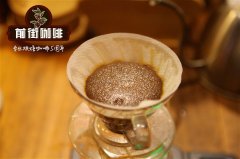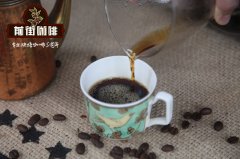The correct drinking method of dried Fruit Coffee on Yejia Coffee Tree _ suggestion on the parameters of dried Fruit Yega Chefe

Professional coffee knowledge exchange more coffee bean information please follow the coffee workshop (Wechat official account cafe_style)
Introduction to the origin of Yejia Xuefei coffee
Ethiopia is the first country to discover coffee, and it belongs to the most important producing country in terms of coffee quality and output, with an annual production of about 350000 tons. Ethiopia is famous all over the world for its mocha beans in Hara, among which Yirgacheff is located in the south of Sidamo in a small area with an elevation of 1700 to 2100 meters above sea level. Arabica coffee beans produced are regarded as the best coffee in Africa. Among the coffee beans, Yejasuefi is one of the best quality coffee in the world and the most expensive coffee in Ethiopia.
Yega Xuefei can drink bright sour taste, with lemon and citrus fruit and sweetness, light floral aroma and balanced acidity, interpret the taste just right, taste similar to the illusion of tea taste, strong and soft layers, taste from sour to sweet to sweet, making the sour very mild, because the aroma is clear With its unique lemon aroma, honey sweetness and floral aroma, pleasant sweet fruit acidity and multi-layered rich taste, it has become the most unique flavor of coffee and is known as the best coffee bean in Ethiopia. Therefore, it is loved by many people, and it is also referred to as the queen of coffee by the Japanese.
What is dried fruit on a tree?
The dried fruit on the tree, literally, is the fruit dried on the tree. Some farmers deliberately let coffee berries naturally dry "dried on the tree" or "Tree Dry-Process" on trees-coming from beans harvested at a late stage, after the cherry has already dried on the tree. To put it simply, it is in the sunny season, let the coffee fruit bask in the purple-black dried fruit on the tree, and then use the scaffolding sun after harvest. The moisture and sweetness of these hand-harvested purple-black dried fruits are still very uneven, making their moisture more uniform and sweetness more fully developed through the sun on the scaffolding.
Dried on the tree is common in Yemen and Brazil, and it has recently been found that beans in Bali in Indonesia use this technique of breaking branches without picking, making the coffee sweeter but less bright. At the same time, this will keep the coffee berries on the tree longer without fermenting, but only if the weather temperature is moderate and the coffee fruit (tree) is in shade. It is best not to do this in areas with low elevations and high temperatures, because coffee berries begin to ferment directly on the trees and affect the flavor quality of coffee.
How is the dried fruit on the tree handled, and what are the characteristics?
In the drying process, the treatment process is different from the traditional sun treatment, which requires sufficient sunlight so that the fruit can be evenly dried on the tree, and must be harvested one by one by hand. in order to ensure that each picked fruit is dry enough, and only the fruit from the top to the middle of the tree can only be harvested, and the fruit below the middle of the tree is not dry enough because of insufficient sunshine. There is no way to use it, in other words, there will be a lot of fruit that can not be used to be discarded or sold cheaply.
When the coffee cherry is naturally dried on the tree, it not only fully absorbs the nutrients of the tree, but also absorbs a lot of sunlight, so the aroma, sweetness and flavor will be richer. However, the relative harvest time is reduced, and less fruit will fall when dried, so it becomes a more expensive boutique coffee. In this way, the dried fruit on the tree has its own unique taste, which is not only clean and delicious, but also sour and sweet.
Different ways of handling, like different ways of cooking, naturally have different characteristics of taste:
Different from the traditional sun treatment, this treatment is more difficult to handle and control, it needs to be more careful, coffee cherry drying on the tree to maintain the integrity of flavor and outstanding sweetness.
The flavor of dried fruit coffee on Yejia Coffee Tree.
Dried fruits on Yejia Xuefei trees are insolated in YIRGACHEFE GMel 1
Production area: GEDEO
Altitude: 1900-2200 m
Variety: Arabica species
Location: eastern part of the traditional producing area of Yejia Shifei
Bean seed: HEIRLOOM
Treatment: dried fruit on the sun tree
Treatment process: the treatment process is different from the traditional sun treatment, this treatment is difficult to deal with and control, it needs to be more careful, coffee cherry drying on the tree to maintain the integrity of flavor and outstanding sweetness.
Flavor: rose and jasmine floral aromas, citrus and lemon fruit aromas, red wine aromas charming, sweetness and fruity mellow thickness.
Cup test: 89 points +
How to make Yega Chefee Coffee?
Qianjie Coffee hand reference: weigh 15g [] coffee powder, pour it into a grinder to grind moderately, the ground particles are slightly thicker than salt, we use BG bean grinder to scale 5R (standard sieve pass rate 60%), water temperature 90 degrees, V60 filter cup extraction.
The hot water in the hand flushing pot draws a circle clockwise with the center of the filter cup. Start the time when brewing, brew the coffee to 30g in 15 seconds, then stop the water injection, and when the time is up to 1 minute, the second water injection. The second water injection is the same as before, draw a circle clockwise with the center of the filter cup, and the water flow should not rush to the place where the coffee powder is connected with the filter paper, so as not to produce channel effect.
Coffee powder to the outermost circle to set aside a circle, and then another circle to the middle, 2 minutes 20 seconds, to the coffee to 220g, brewing coffee is finished.
| | Japanese ice hand punch [] |
Qianjie coffee ice hand [] reference:
Yega Chuefei Coffee [], light medium roast, BG bean grinder scale 5m (standard sieve pass rate 67%)
20 grams of powder, 150 grams of ice, 150 grams of hot water. The water temperature is 91 ℃ higher than the recommended normal hand flush, then 1 ℃ higher, normal grinding small Fuji 3.5 scale, ice hand flushing is slightly thinner half grid-small Fuji 3 scale.
The amount of steaming water is 40 grams and the steaming time is 30 seconds.
Water injection by stages, 60 grams of water in the first section and 40 grams of water in the second section. Use a thin but high water injection column and stir hard to make the coffee powder fully tumble, but be careful that the water level is not too high and do not rush to the edge of the filter paper.
The whole extraction time is about two and a half minutes (close to the normal extraction time of 20 grams of powder).
END
Important Notice :
前街咖啡 FrontStreet Coffee has moved to new addredd:
FrontStreet Coffee Address: 315,Donghua East Road,GuangZhou
Tel:020 38364473
- Prev

How many grams of powdered coffee are washed by hand? is it good to wash Yega Apo?
Professional coffee knowledge exchange more coffee bean information please follow coffee workshop (Wechat official account cafe_style) Yega Xuefei Coffee A Bao Yirga cheffe Abol country: Ethiopia production area: Yega Xuefei processing Plant: Kochere Variety: Tea-tike altitude: 20002200m Flavor: Jasmine / Orange / Black Qiao Grade: G1 treatment method: water washing method
- Next

How to wash Yega 90 + Lomitasha hand-brewed coffee? how about 90 + Lomitasha coffee beans?
Professional coffee knowledge exchange more coffee bean information Please follow the coffee workshop (Wechat official account cafe_style) many people asked me, what on earth is 90 +? To put it simply, 90+ is a high-quality raw bean company in the United States, touting that their raw beans are super-high-quality products with a cup test of more than 90 points, mainly in Ethiopia. Their raw beans are famous for their cleanliness, berry tone, and high price.
Related
- Detailed explanation of Jadeite planting Land in Panamanian Jadeite Manor introduction to the grading system of Jadeite competitive bidding, Red bid, Green bid and Rose Summer
- Story of Coffee planting in Brenka region of Costa Rica Stonehenge Manor anaerobic heavy honey treatment of flavor mouth
- What's on the barrel of Blue Mountain Coffee beans?
- Can American coffee also pull flowers? How to use hot American style to pull out a good-looking pattern?
- Can you make a cold extract with coffee beans? What is the right proportion for cold-extracted coffee formula?
- Indonesian PWN Gold Mandrine Coffee Origin Features Flavor How to Chong? Mandolin coffee is American.
- A brief introduction to the flavor characteristics of Brazilian yellow bourbon coffee beans
- What is the effect of different water quality on the flavor of cold-extracted coffee? What kind of water is best for brewing coffee?
- Why do you think of Rose Summer whenever you mention Panamanian coffee?
- Introduction to the characteristics of authentic blue mountain coffee bean producing areas? What is the CIB Coffee Authority in Jamaica?

